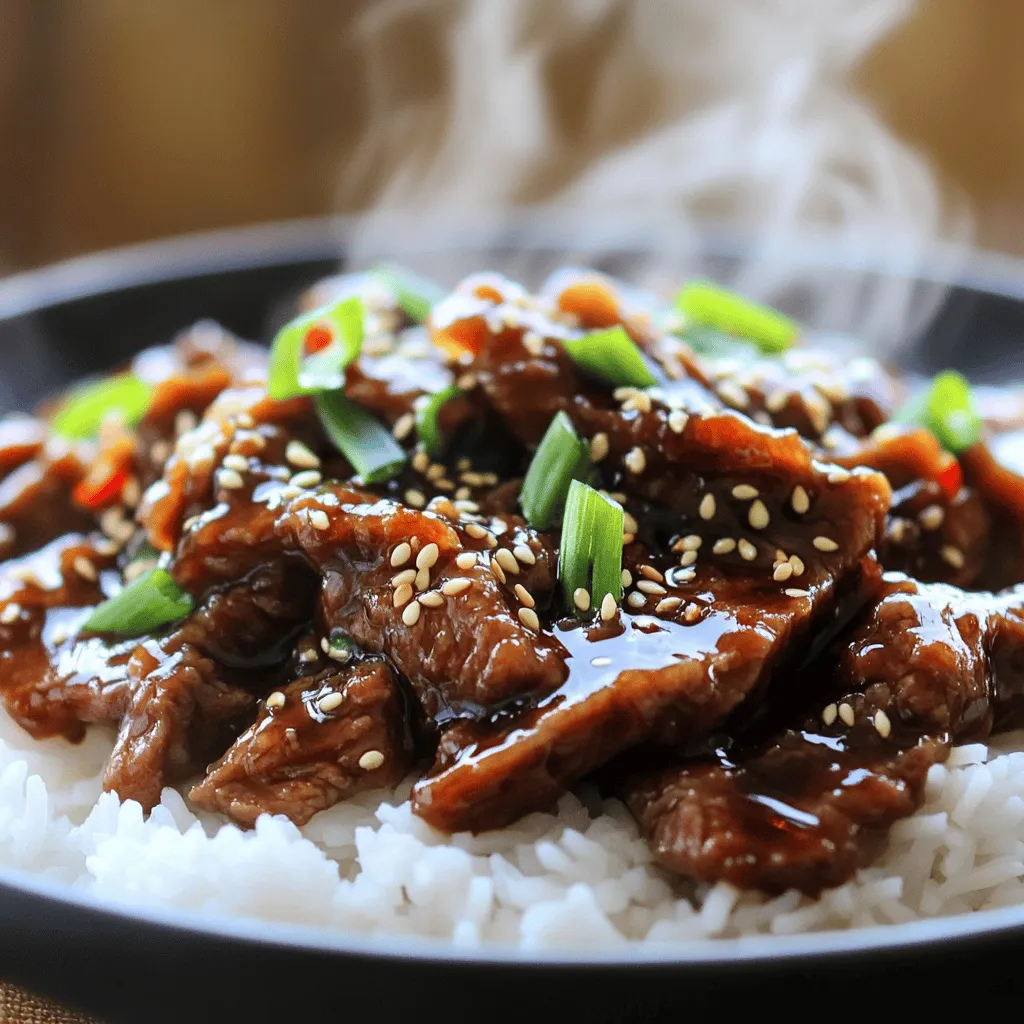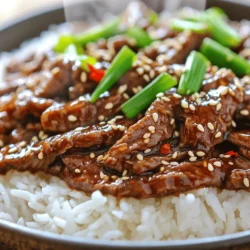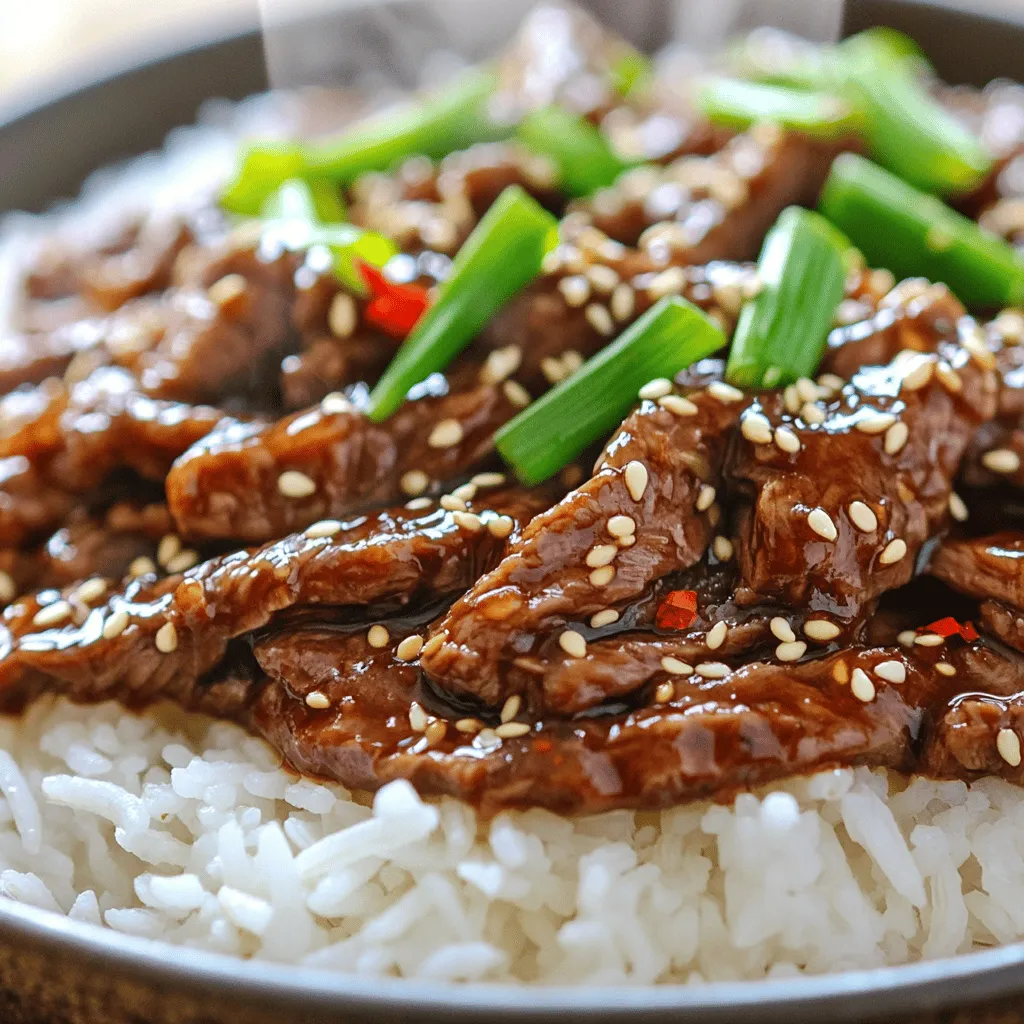Ready for a mouthwatering dish that beats takeout? Get ready to make Mongolian Beef that’s quick, tasty, and sure to impress! In this post, I’ll walk you through every step, from selecting the right ingredients to achieving that restaurant-quality flavor. You will love how simple and satisfying it is. Let’s dive in and transform your kitchen into a flavor-packed haven!
Ingredients
List of Ingredients
- Flank steak and its preparation: You need 1 pound of flank steak. Slice it thinly against the grain. This helps make the meat tender. Thin slices cook fast and get crispy.
- Cornstarch for coating: Use 1/2 cup of cornstarch. Toss the sliced beef in it until fully coated. This gives the beef a nice crunch when cooked.
- Essential aromatics and seasonings: Gather these key items:
- 3 tablespoons vegetable oil for frying
- 1 teaspoon minced ginger for a warm flavor
- 3 cloves of garlic, minced for richness
- 1/4 cup low sodium soy sauce for saltiness
- 1/4 cup brown sugar for sweetness
- 1/2 cup green onions, chopped (white and green parts separated) for freshness
- 1/4 teaspoon black pepper for spice
- 1/4 teaspoon red pepper flakes (optional) for heat
- Sesame seeds for garnish, adding a nice touch
These ingredients come together to create a dish that is quick and tasty. They also offer a well-balanced flavor, making your Mongolian beef better than takeout.
Step-by-Step Instructions
Preparation of the Beef
First, slice the flank steak thinly against the grain. This keeps the meat tender. Next, toss the sliced beef in cornstarch until it is fully coated. This helps create a crispy texture. Let the beef rest for about 10 minutes. This resting time allows the cornstarch to stick better.
Cooking the Beef
Heat 3 tablespoons of vegetable oil in a large skillet over medium-high heat. Make sure the oil is hot before adding the beef. Cook the beef in batches. This step helps avoid overcrowding, which can make it steam instead of crisp. Cook for 2-3 minutes on each side until they turn golden brown. Once done, place the beef on paper towels to drain excess oil.
Making the Sauce
In the same skillet, add 1 teaspoon of minced ginger and 3 cloves of minced garlic. Sauté for about 30 seconds until fragrant. Then, add 1/4 cup of low sodium soy sauce, 1/4 cup of brown sugar, 1/4 teaspoon black pepper, and red pepper flakes if you want heat. Stir well and let it simmer for 2-3 minutes. This helps the sauce thicken slightly.
Final Assembly
Return the cooked beef to the skillet. Toss it gently to coat with the sauce. Add the white parts of the 1/2 cup of chopped green onions. Stir and cook for an additional 1-2 minutes until heated through. Finally, remove from heat and garnish with the green parts of the green onions and sesame seeds.
Tips & Tricks
Achieving Restaurant-Quality Flavor
Using low sodium soy sauce is key. It gives rich flavor without too much salt. This helps balance sweetness and heat. Use brown sugar for sweetness and red pepper flakes for spice. Adjust these to your taste.
Cooking Techniques
For browning meat, use a hot skillet with oil. This keeps the beef crispy and tender. Cook in batches to avoid steaming. High heat helps the meat cook fast. It seals in juices and gives a nice crust.
Presentation Tips
Serve your Mongolian beef over rice or noodles. This makes a full meal. Drizzle extra sauce on top for added flavor. Garnish with green onions and sesame seeds. This adds color and makes the dish look fancy.

Variations
Ingredient Substitutions
You can easily swap flank steak for other cuts. Sirloin works well if you want a more tender bite. For those who want a lighter option, chicken or tofu can fit nicely too. If you need a soy sauce alternative, try tamari or coconut aminos. Both options give a similar taste but cater to different dietary needs.
Flavor Variations
Add some veggies to your dish for extra crunch! Bell peppers and broccoli bring color and nutrients. You can also adjust the spice levels. If you like heat, toss in more red pepper flakes. This small change can make a big impact on flavor.
Dietary Considerations
If you want to make this dish gluten-free, use tamari instead of soy sauce. For a low-sugar version, cut down on brown sugar or use a sugar substitute. These easy swaps help you enjoy Mongolian beef while sticking to your dietary goals.
Storage Info
How to Store Leftover Mongolian Beef
To keep your Mongolian beef fresh, place it in an airtight container. Let it cool first. Store it in the fridge for up to four days. Always label the container with the date. This helps you track freshness.
Freezing Instructions
To freeze leftover Mongolian beef, follow these steps:
1. Cool the beef completely.
2. Place it in a freezer-safe bag or container.
3. Remove as much air as possible before sealing.
4. Label with the date.
You can freeze it for up to three months. When ready to eat, thaw it overnight in the fridge. Reheat in a skillet over low heat until hot.
Shelf Life
In the fridge, Mongolian beef lasts about four days. If you freeze it, it can stay good for three months. Always check for any off smells or changes in texture before eating. This ensures your meal is safe and tasty.
FAQs
Can I make Mongolian Beef ahead of time?
Yes, you can make Mongolian beef ahead of time. To do this, follow these steps:
- Cook as normal: Prepare the dish completely.
- Cool it down: Let it cool to room temperature.
- Store it: Place it in an airtight container in the fridge for up to three days.
When you’re ready to eat, reheat it in a pan over medium heat. Stir it often to avoid burning. You can also add a splash of water or extra soy sauce to keep it moist.
What is the best cut of beef for Mongolian Beef?
Flank steak is the best cut for Mongolian beef. It has a rich flavor and cooks well. Here’s how it compares to other cuts:
- Flank Steak: Tender, easy to slice thin, and absorbs flavors well.
- Sirloin: A bit tougher and less flavorful, but still a good option.
- Ribeye: Very tender and juicy, but it may be too fatty for this dish.
Flank steak remains the top choice for its flavor and texture.
How can I make Mongolian Beef spicier?
If you want more heat in your Mongolian beef, here are some tips:
- Add more red pepper flakes: Start with an extra 1/4 teaspoon and adjust to taste.
- Use fresh chili peppers: Slice up fresh chilies and add them while cooking.
- Include sriracha or chili paste: A spoonful can bring a nice kick.
Adjust the spice to match your heat preference.
Is Mongolian Beef gluten-free?
Traditional Mongolian beef is not gluten-free because it uses soy sauce. However, you can make it gluten-free by using these alternatives:
- Tamari: A gluten-free soy sauce that tastes great.
- Coconut aminos: A soy-free option that’s also gluten-free.
By making these swaps, you can enjoy this dish without gluten.
In this post, we explored how to make Mongolian Beef from scratch. We covered key ingredients like flank steak and cornstarch. I shared steps for preparing, cooking, and assembling the dish, along with tips for rich flavor. Variations allow for personal touches, making it versatile. Finally, I highlighted storage tips to maintain freshness. Enjoy making this dish and impress your friends and family with your skills!


